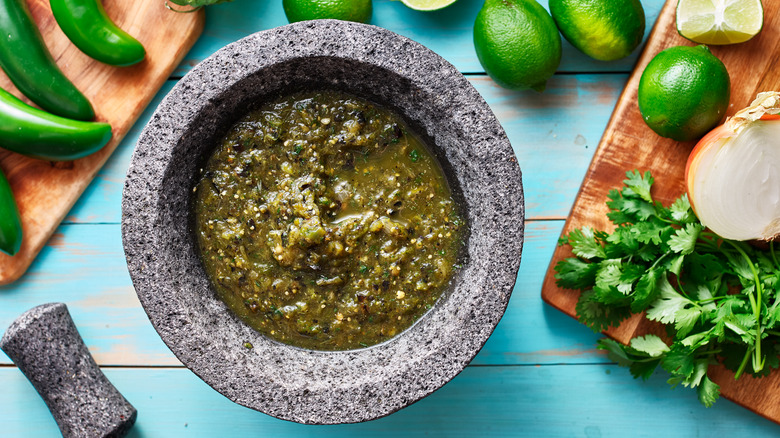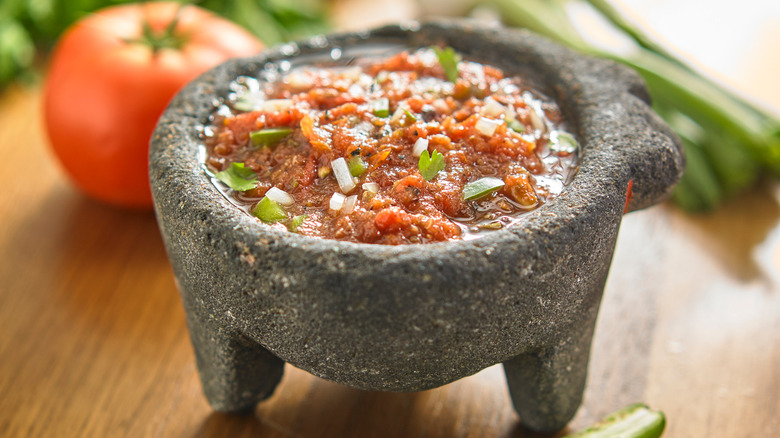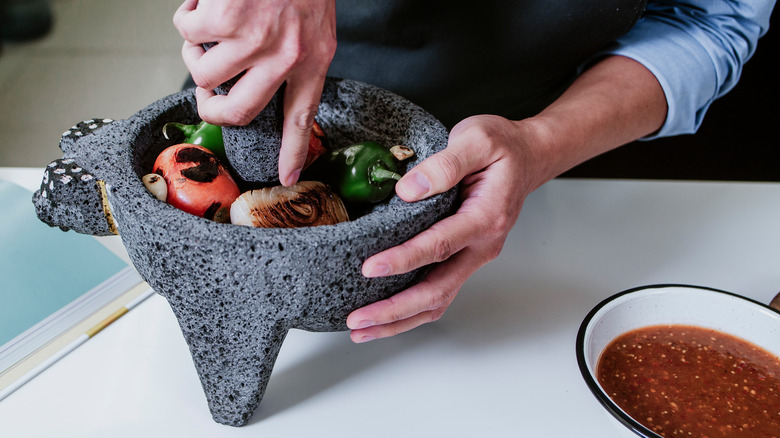How To Test The Authenticity Of Your Molcajete
The molcajete has been in use for thousands of years in Mesoamerica, and was a staple tool for both Aztec and Mayan cultures in Mexico. It's essentially a mortar and pestle, and was one of two versions of this primitive grinding tool kit in use by ancient cultures in the region. The molcajete is the mortar, while its tejolote acts as the pestle to crush and grind ingredients. The molcajete's popularity has carried on into the present day — in Mexico, and increasingly in the U.S. as well — with its flavor-rich methods preferred to blenders for the preparation of traditional food favorites like salsas and guacamoles.
Real molcajetes embody a unique blend of traditional craftsmanship and refined artistry. These three-legged bowls are typically hand-carved from volcanic stone, a fact which accounts for both their incredible ability to withstand and retain heat. The former is frequently on display in Mexican restaurants, where sizzling hot entrées are served in molcajetes, not only because the presentation looks amazing, but because they also help the food stay warm while diners are consuming it. Volcanic stone, after all, can retain heat for up to 20 minutes.
Those new to molcajetes need to know a few things, however. One is how to properly cure their molcajete before using it for the first time. But even before that, they need to know that the product they are buying is legitimate, and not a fake molcajete made largely from cement.
The differences between real and cement molcajetes
The presence of pores is a distinguishing factor in real molcajetes and serves two main purposes. First, they need to be cured to prevent grit from the pores from mixing with food. Second, these pores enhance the flavor of dishes, making molcajetes a valued tool passed down through generations in Mexican families. Flavor gets into the pores and stays there, enhancing future dishes with an extra touch.
Another feature is that they're carved by hand by traditional artisans. Working with volcanic stone can be challenging, especially for artisans using only a hammer and chisel. So real molcajetes aren't always perfectly symmetrical. These two aspects are important, as they help to distinguish legitimate molcajetes from cement-laden fakes. The latter, for example, are typically made from molds, and thus always look perfect. They also lack visible pores — although cement is in fact porous — and thus look way too smooth. It's worth noting that the grit, which may require a cure, is actually proof that volcanic stone was used in construction.
These are telltale signs, but don't worry if your eyes aren't good enough to spot them. There are also two other surefire ways to determine whether a molcajete is real, or just another cleverly constructed imitation.
Two surefire tips for establishing your molcajete's bona fides
To find out quickly whether a molcajete is real or fake, pour a little water on the bottom, and leave it there for a few minutes. Real molcajetes can sometimes leak if they have too many pores, but even so, there's a likelihood of some water remaining after a few minutes. That won't be the case with cement molcajetes, as they typically absorb the water almost immediately. You've probably seen the way water soaks into cement after it rains. That's what the bottom of a cement-added molcajete looks like after the water test.
The other dead giveaway involves using a knife, and means you've probably already purchased the molcajete. This sort of behavior, after all, would be pretty brazen in front of store employees, particularly if they're selling cement molcajetes. Why? Because scratching these imitation versions with a knife will definitely leave a permanent mark. That won't happen, of course, if the molcajete is made from genuine volcanic stone, although the knife may produce a little dust.
What should you do if you've already purchased a cement molcajete? It probably shouldn't be used, at least not for food purposes, as concrete ingredients like sand and gravel can end up in your guacamole. The best course of action is to return it, hopefully for a full refund. Then buy a new one — at least now you know what to look for!



